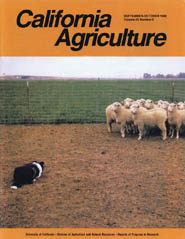All Issues

Cover:
Fila, a prize-winning border collie, keeps a wary eye on sheep in an alfalfa grazing plot. The mother of Butch, the official sheep dog at UC Davis, Fila helped owner Dick Pelton move the sheep between plots in a study of the effect of grazing on alfalfa.
September-October 1988
Volume 42, Number 5
Volume 42, Number 5





